Ultimate Kitesurfing Guide for Beginners and Enthusiasts
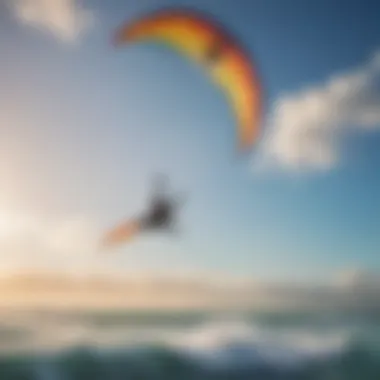
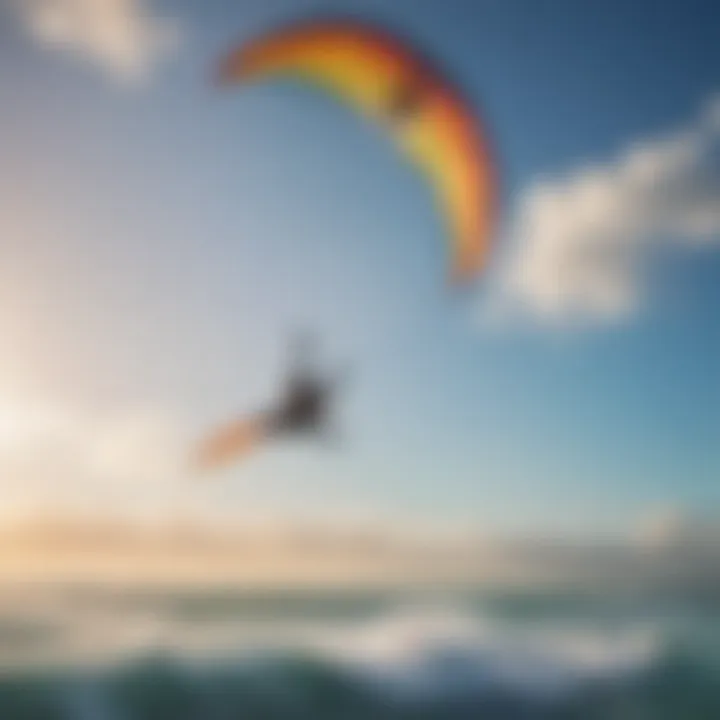
Intro
Kitesurfing is not just a sport; it’s a thrilling dance with the wind and water. Every kiteboarder, from novice to seasoned expert, seeks to harness the power of the elements, feeling the rush as the waves crash around them. This guide is designed for those who are eager to learn the art of kitesurfing—complete with essential skills, gear insights, and safety protocols. Whether you’re drawn to the excitement of riding the waves or the challenge of mastering your technique, this article will pave your way to becoming a confident participant in the kitesurfing community.
We’ll dive into every important detail, leaving no stone unturned. We will discuss the right equipment to get started, delve into fundamental techniques, and explore advanced maneuvers for those who wish to take their skills to the next level. Understanding how to navigate the waves safely not only enhances your personal experience but also contributes to the bigger picture of kiteboarding as a responsible community.
Equipment Insights
Understanding the equipment you use is crucial to enjoying kitesurfing safely and effectively. Choosing the right gear can greatly influence your performance and enjoyment.
Latest Gear Reviews
When it comes to kitesurfing, having the right kite can make all the difference. Look for the latest models with features like precision control and durability. For instance, the Duotone Rebel has been praised for its versatility; whether it's high winds or smooth breezes, it adapts to a variety of conditions. Similarly, the Naish Pivot has garnered a fan base due to its excellent upwind performance.
Apart from kites, you’ll need a suitable board. The Slingshot Misfit is a popular choice among beginners for its stability and ease of maneuverability, while advanced surfers often opt for the Liquid Force Rocket for its high-speed capabilities.
"Choosing the right kite and board is more than just preferences—it’s about understanding your local conditions and personal style."
Essential Gear Maintenance
Regular maintenance of your kitesurfing gear can prolong its life and improve performance. Here are some tips:
- Inspect Your Kite: After each session, look for any tears or abrasions. Small issues can escalate quickly if ignored.
- Wash Your Gear: Saltwater can be corrosive. Rinse your kite, lines, and harness in fresh water after each use to prevent wear.
- Store Properly: When not in use, store your kite flat and out of direct sunlight. Avoid leaving it folded for long periods, as this may cause creases in the fabric.
Technique Exploration
Once you have your gear sorted, the next step is honing your skills in kitesurfing.
Beginner Techniques
For beginners, mastering a few basic techniques is essential. Start with the following:
- Body Dragging: This technique involves using the power of the kite to drag yourself through the water. It's a great way to gain confidence before trying to stand on the board.
- Water Starts: Practice positioning your board correctly and using the kite’s pull to get up on the board. Focus on keeping your weight centered.
Advanced Maneuvers
As you gain experience, you might want to take on advanced techniques to impress your friends:
- Jumping: Learn how to pop by bending your knees and pulling up on the kite as you ride.
- Tricks: Once you’re comfortable with jumping, explore tricks like the 360, or even a handle pass. These will take time and practice, but they're sure to leave your audience in awe.
Prologue to Kitesurfing
Kitesurfing is not just a sport; it's a thrilling blend of wind, water, and the wild. This section sets the stage for understanding why kitesurfing has captured the hearts of enthusiasts around the globe. From its roots to its modern maneuvers, the sport presents a unique opportunity for both adventure and self-expression. To dive into kitesurfing is to embrace not just the adrenaline rush, but also the meticulous craft of mastering nature's elements.
Understanding the Sport
At its core, kitesurfing involves riding a board while being pulled by a large kite. It's a symphony of coordination and timing, as riders harness the wind to glide across water. But it’s more complex than just hopping on a board and flying a kite. Understanding how various factors like wind direction, speed, and water conditions can impact performance is essential.
An aspiring kitesurfer must grasp the dynamics of kite flying. You’ll need to learn how to control the kite's position in the air, adjusting for forces acting on you and your board. Mastering this connection serves as the bedrock for all maneuvers, whether you’re aiming to perform jumps or simply cruising along the shoreline.
The Evolution of Kitesurfing
Kitesurfing has come a long way since its inception in the 1970s, when the first prototypes appeared. What started as a simple idea has transformed into a sophisticated sport. Throughout the years, technology and design have evolved, allowing for lighter kites and streamlined boards, maximizing performance and safety.
Innovations such as inflatable kites and shortboards drastically changed the game in the late 1990s. These advancements have made the sport accessible to a wider range of skill levels, transforming kitesurfing into a mainstream endeavor. However, the essence of kitesurfing remains intact—it’s still about harnessing the wind for that exhilarating ride.
Kitesurfing vs. Other Watersports
Kitesurfing inevitably raises the question: how does it stack up against other watersports? To put it simply, kitesurfing is a versatile and exciting option. While windsurfing and wakeboarding have their own draws, kitesurfing offers a unique fusion of skills and experiences. Here’s a breakdown of what sets kitesurfing apart:
- Flexibility of Conditions: Kitesurfers can ride in a variety of winds and water conditions, from flat water to waves.
- Portable Equipment: The gear is relatively compact, allowing for easy transport compared to some other sports that require boats or extensive setups.
- Thrill Factor: The ability to jump and perform tricks adds an adrenaline rush that isn’t as prioritized in other watersports.
In summary, kitesurfing combines the potently invigorating aspects of many watersports, while offering its own distinct identity. Understanding the fundamentals of kitesurfing is crucial to appreciating what lies ahead in this guide.
Equipment Overview
Understanding the equipment involved in kitesurfing is crucial for both safety and progression in the sport. The right setup can mean the difference between a thrilling ride and a troublesome fall. Between kites, boards, harnesses, and safety gear, each component plays a key role in ensuring a smooth and enjoyable experience on the water. Selecting the right equipment not only enhances performance but also boosts confidence, allowing newcomers to focus more on skill-building rather than gear-related issues.
Kites: Types and Features
Kites, the heart of kitesurfing, come in various types, each designed for specific conditions and riding styles. Here are some common types you might encounter:
- C-Kites: Known for their powerful lift and upwind performance. These are often favored by tricks and freestyle enthusiasts.
- Delta Kites: These are versatile and user-friendly, offering stability and ease of use, making them ideal for beginners.
- Bow Kites: Engineered for maximum depower and range, they are great for different wind conditions and are often recommended for progressing riders.
When selecting a kite, pay attention to the following features:
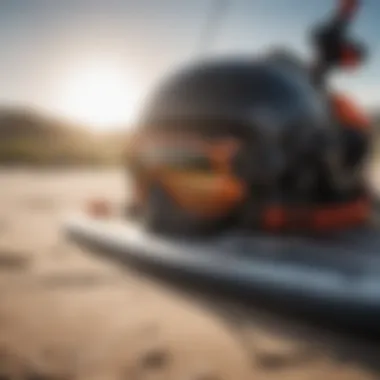
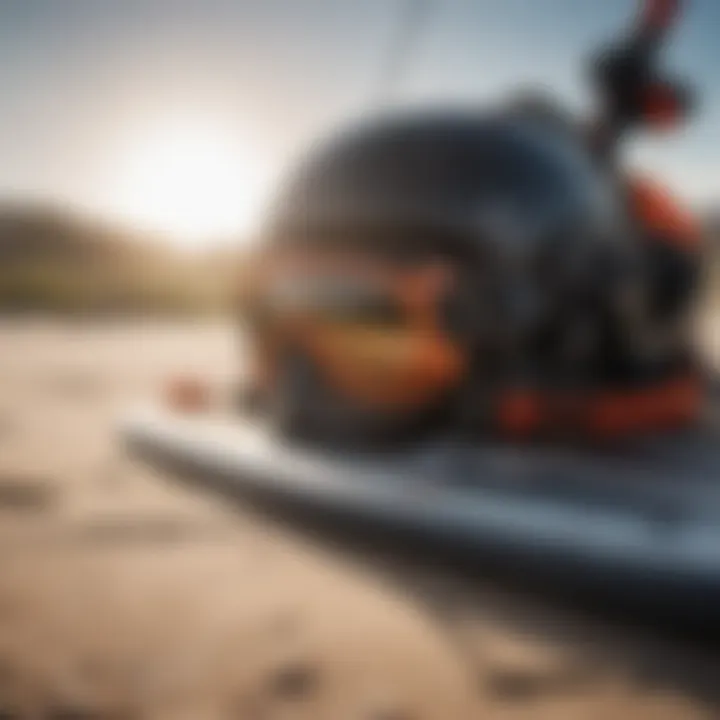
- Size: The larger the kite, the more power it generates, but a smaller kite is better for strong winds. It’s important to match the kite's size to your skill level and local wind conditions.
- Material: Look for durable materials that withstand wear and tear as you progress in the sport. Quality kites are often made from ripstop nylon or polyester.
Boards: Selecting the Right Size and Style
Picking the right board can be a game-changer in your learning journey. Boards come in various styles and sizes, each designed to address specific needs:
- Directional Boards: These are surf-style boards, often used in waves. They provide excellent control and maneuverability.
- Twin-Tip Boards: Most common for beginners, these bidirectional boards offer versatility and allow for easy riding and jumping in both directions.
Size matters too. A general rule of thumb is:
- Lighter Riders: Should opt for smaller boards for better control.
- Heavier Riders: Larger boards provide more surface area for stability.
Harnesses: Importance and Choices
A good harness can make all the difference in your comfort level while kitesurfing. Harnesses can be broadly categorized into:
- Waist Harnesses: These sit around your waist and are popular among many kitesurfers for their freedom of movement. They're suitable for regular riding and freestyle maneuvers.
- Seat Harnesses: Offering more back support, these are ideal for beginners and those who prioritize comfort over mobility.
When choosing a harness:
- Fit: Ensure it’s snug without being too tight. A well-fitted harness will reduce the risk of chafing.
- Padding: Extra padding is beneficial, providing both support and comfort during longer sessions.
Safety Gear Essentials
Safety must never be an afterthought in kitesurfing. Having the right safety gear can help prevent injuries and ensure you are prepared for emergencies. Key items include:
- Helmet: Protects your head during a fall or collision.
- Impact Vest: Adds flotation and helps shield against the surf.
- Safety Leash: Ensures your kite doesn’t drift away if you have to release it, which is critical in windsurfing.
Remember, investing in safety gear is investing in your peace of mind.
Ultimately, the right equipment, from kites to harnesses, forms the foundation of a rewarding kitesurfing experience. Make informed decisions about your gear, and ensure each piece supports your learning and growth in the sport.
Fundamentals of Learning
Learning to kitesurf is like building a house; you need a solid foundation before you can install the windows and decorate the walls. The fundamentals of learning kitesurfing serve as that essential groundwork, setting the stage for success in this thrilling sport. Without grasping the basics, one can easily find themselves tangled in confusion or, even worse, facing safety issues while out on the water.
Focusing on the fundamentals covers various crucial elements, including mastering core techniques, understanding environmental conditions, and the mechanics of kite control. Learning these principles not only enhances performance but also instills confidence, making each outing on the water enjoyable and safe.
Mastering the Basics
Before anyone rushes into the waves, hitting the water right away isn’t recommended. First, it’s vital to master the basics of kitesurfing, which involves understanding how to launch and land the kite safely, maintaining proper stance, and controlling the board. Each of these basics intertwines, forming a comprehensive skill set that can elevate a beginner into an intermediate rider in due time.
- Kite Launching and Landing: Learning these techniques is fundamental. An error here can mean a trip to the emergency room, or worse, an unfortunate incident involving another kitesurfer. Starting on land, practice these steps before heading to the water.
- Stance and Balance: An appropriate riding position is like finding the right groove in a melody. It requires trial and error, along with adjustments based on your comfort and performance.
- Basic Maneuvers: Roll with the waves, the ability to make basic turns and transitions comes from practice. One step at a time, these maneuvers will feel natural.
Understanding Wind and Water Conditions
Before setting sail, understanding wind and water conditions can not be overstated. The wind can be either your best friend or bitter enemy. Knowing how to read wind patterns, tidal currents, and wave heights adds an element of safety to your excursions.
- Wind Speed and Direction: Not all winds are created equal. Learning how to gauge wind conditions can save from struggling on a non-ideal day. Generally, beginners should aim for winds between 12 to 20 knots, which provide a manageable experience.
- Water Conditions: Knowing how to handle choppy or flat waters gives you an edge. Remember, experience helps significantly, so don’t shy away from asking local kitesurfers about water conditions specific to your area.
"Understanding the elements is more than just knowledge; it's the key to mastering the sport."
Kite Control Techniques
Kite control techniques are the heart and soul of kitesurfing. Mastering this will directly influence your riding experience.
- Bar Control: Simplicity here is deceiving. The bar controls everything; pulling on one side can lead to a swift turn while pushing out will de-power the kite. Practice makes perfect.
- Kite Angles: The angle of your kite in relation to the wind is a powerful determinant of speed and lift. Learn to adjust the kite to slice through the wind with finesse.
- Body Positioning: Understand how shifting your weight can maneuver the kite in such a way that can effortlessly transition from a gentle ride to an exhilarating speed.
- Edging Techniques: The ability to edge your board properly is fundamental in maintaining direction and speed. Practicing this technique builds confidence and allows for smoother rides.
Learning to control your kite can make or break your experience. Every little adjustment counts and understanding these principles can lead to more enjoyable sessions and progression in the sport. As you build on these fundamentals, you’ll find that each kite session becomes less about survival and much more about exhilaration.
Safety Protocols
When it comes to kitesurfing, upping the thrill factor of flying over water also means ensuring safety protocols are firmly in place. These protocols act as safeguards, enabling you to focus on the excitement rather than worrying about unexpected mishaps. By understanding and adhering to these safety measures, you vastly increase your chances of enjoying the sport without the specter of accidents. The waters can be unpredictable, and having a solid foundation of safety practices is crucial for every participant, from novices to seasoned pros.
Pre-flight Safety Checks
Before you even think about launching your kite, a systematic pre-flight safety check should be high on your list. This routine verifies that everything is in order and functioning as it should be. Here's a quick checklist for you:
- Inspect Your Gear: Every line, strap, and buckle should be checked thoroughly. Look for fraying lines, damaged kites, or loose fittings. One small oversight can lead to a big problem.
- Wind Conditions: Check to make sure the wind conditions are suitable for your skill level. Is it consistent? Are there gusts? Too much wind can complicate an otherwise fun day.
- Launch Area: Ensure your launch area is free of obstacles like other kiters or debris. An unobstructed area will make all the difference during the takeoff phase.
"Safety is not just a priority; it should be a way of life." This quote resonates profoundly in the context of kitesurfing.
Taking these steps might seem mundane, but they increase your awareness of potential risks, thus, forming a habit that keeps you and others safe.
Emergency Procedures
Even with meticulous pre-flight checks, emergencies can occur. Knowing what to do in those critical moments can make all the difference. Here are some key emergency procedures to keep in your back pocket:
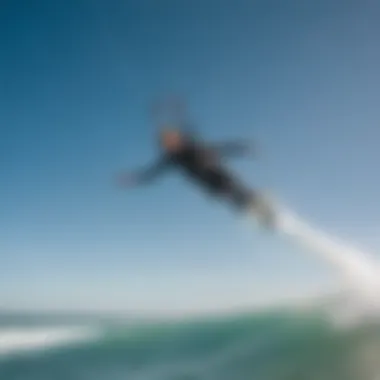
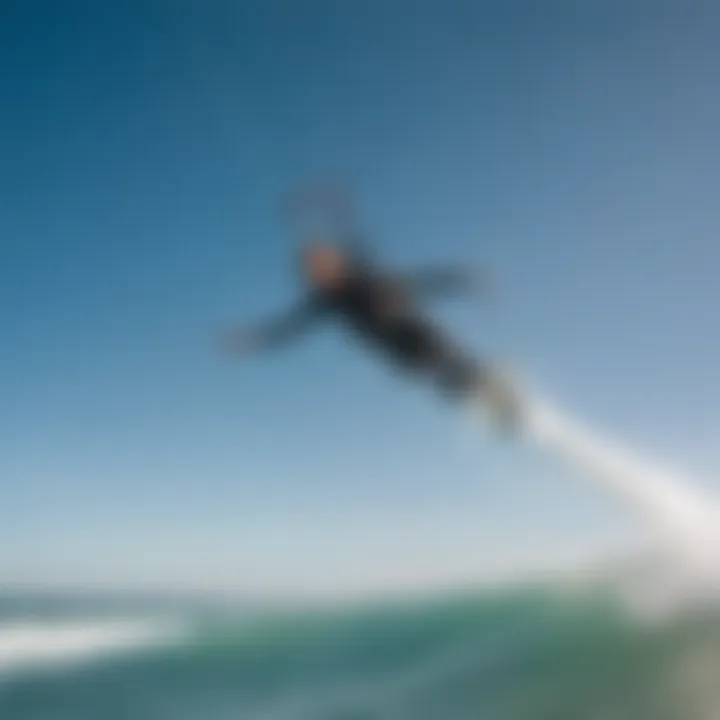
- Depower Your Kite: If things go sideways, being able to depower your kite immediately is paramount. Locate the trim line or safety release mechanism to ensure you can regain control and minimize the kite's pull.
- Signal for Help: Should you find yourself needing assistance, use hand signals or your whistle (if you have one) to alert nearby kiters or lifeguards. Being aware of your surroundings makes signaling much easier.
- Self-Rescue Techniques: Learning self-rescue techniques is critical for any kitesurfer. If you end up in the water, practice how to use your board for flotation while you assess your situation and wait for help.
In a sport like kitesurfing, where conditions change rapidly, these procedures can be your lifeline. Develop them and practice them regularly to instill them in your muscle memory.
Understanding Right of Way Rules
Navigating kitesurfing waters isn’t just about being stoked to ride; it also involves understanding right of way rules. Whether you are a seasoned rider or just starting out, knowing who has precedence is key to keeping the flow on water safe and enjoyable. Here’s a quick breakdown:
- Downwind Rider: The rider traveling downwind always has the right of way. This is crucial because they have less maneuverability and more speed compared to an upwind rider.
- Jumping or Tricks: If someone is executing jumps or complex tricks, they are also afforded right of way. However, they must be conscious of their surroundings to avoid collisions.
- Avoid Crossing Paths: If two riders approach each other, it’s best practice to avoid crossing paths directly. Instead, take a wide turn to prevent any unwanted brush with another kite or surfer.
Knowing these basics can help avert accidents and keep everyone safe on the water. Stay aware, communicate with fellow kiters, and enjoy the ride while respecting these rules.
Safety protocols form the bedrock of a successful kitesurfing adventure. They may not always be the most thrilling aspect of the sport, but keep in mind that safety enables thrill, not the other way around. Take these practices to heart to become a responsible and informed participant in the kitesurfing community.
Learning Pathways
When it comes to mastering kitesurfing, having the right learning pathways is crucial. These pathways not only guide novices through the basics but also open doors for continuous development. Choosing the right approach helps individuals build confidence and ensures a solid skill foundation. In a sport characterized by its dynamic nature, understanding how to navigate these learning pathways can make a world of difference in achieving proficiency on the water.
Finding a Qualified Instructor
One of the first steps in your kitesurfing journey is seeking out a qualified instructor. The importance of this cannot be overstated. An experienced instructor will typically understand the nuances of the sport, have first-hand knowledge of local conditions, and can teach you the intricacies that self-study might overlook. Being guided by someone who knows the ropes can fast-track your learning and drastically reduce the risk of accidents. Look for instructors certified by recognized organizations like the International Kiteboarding Organization (IKO) or the American Kiteboarding Association (AKA).
Factors to consider when selecting an instructor include:
- Reputation: Check the reviews and testimonials from past students. Local kitesurfing clubs or online communities, like those on Reddit, can offer valuable insights.
- Experience: A seasoned instructor with extensive teaching experience is likely to provide more comprehensive training than a novice.
- Teaching Style: Some instructors offer more hands-on approaches, while others may prefer theoretical explanations. Find one whose style resonates with you.
Structured Lessons vs. Self-Teaching
Now that you’ve set your sights on learning kitesurfing, you may wonder whether to opt for structured lessons or dive into self-teaching. Both avenues have their merits, but they cater to different learning preferences. Structured lessons provide a path filled with guidance and milestones.
- Benefits of Structured Lessons:
- Self-Teaching:
- Progressive Skill Development: Lessons typically follow a curriculum designed to build skills methodically.
- Immediate Feedback: An instructor can provide tips and corrections in real-time, helping you avoid forming bad habits.
- Safety Awareness: Learning under supervision ensures that you have a grasp of safety protocols from the start.
- Flexible Learning: You can modify your schedule to fit personal commitments, learning at your own pace.
- Cost-Saving: Forgoing lessons can save money, but may introduce risks related to safety and skill acquisition.
- Exploration: Self-learning allows you to test different techniques and approaches that might suit your individual style.
Ultimately, the choice between these two pathways hinges on your personal circumstances and preference.
Progression: From Beginner to Intermediate
Embarking on a progression journey from beginner to intermediate is a source of excitement for many kitesurfers. It signals a phase where skills start to coalesce, allowing riders to experience enhanced freedom and control. The transition itself can be gradual, involving a few stages.
- Skill Solidification: At the beginner level, focusing on kite control, balance on the board, and basic navigational skills sets the stage.
- Intermediate Techniques: As you feel more comfortable, you’ll start tackling water starts and jumps. Learning these moves often requires patience and persistence.
- Joining the Community: Engaging with fellow kitesurfers can also aid your progression. More experienced riders often share advice and the latest trends, further enriching your experience.
Keep in mind that kitesurfing is all about practice. The more time spent on the water, the easier it becomes to develop those intermediate skills.
"Kitesurfing is like learning to dance with the wind, and it takes practice and trust to feel the rhythm."
In summary, navigating the learning pathways in kitesurfing involves careful consideration of instructors, lesson structures, and your own progression. By investing in proper training and remaining committed to improvement, you can elevate your kitesurfing experience immensely.
Practice and Improvement
Practice and improvement lie at the heart of mastering kitesurfing. Just as a painter perfects their strokes or a musician hones their craft, kitesurfers must engage in regular practice to develop essential skills. This section delves into the key elements of practicing effectively, evaluating progress, and adapting to different conditions as you progress on your kitesurfing journey.
Routine Learning Exercises
Routine exercises carry a weighty significance in kitesurfing training. Consistent practice not only builds muscle memory but also instills confidence. Beginners often find themselves overwhelmed when faced with the vast expanse of the ocean and unpredictable winds. Thus, breaking down maneuvers into bite-sized pieces can prove quite beneficial.
- Body Dragging: Start with body dragging, helping to understand how the kite interacts with water. Here, you'll learn to control the kite while in the water, making it less intimidating.
- Board Starts: Once comfortable with dragging, focus on the board start technique. This requires synchronized movement of your body, kite, and board – a dance that demands repetition.
- Basic Jumps: Graduate to basic jumping exercises. Launching yourself off the water’s surface is exhilarating, but it takes practice to master the timing of the kite and your body’s movement.
Incorporate these drills into your regular routine. Think of it as a workout; the more you practice, the more progress you will see. Variate your practice times to get a feel for how conditions change throughout the day.
Evaluating Your Progress
In the unpredictable world of kitesurfing, tracking your progress can feel like searching for needles in haystacks. Yet, taking a moment to pause and assess where you stand is crucial. Keep a journal to jot down your experiences during each practice session. This reflects not just the accomplishments but also the challenges faced during your training.
Evaluating your progress can include:
- Recording the techniques learned.
- Noting areas where you struggled.
- Setting small, achievable goals for each session.
It's essential not to rush the process. Just like new leaves take time to bloom, your skills will burgeon into finesse with each session. Aim for steady improvement – even small achievements matter. If a session feels less productive, remind yourself: every attempt builds your foundation, regardless of the outcome.
"The secret to mastery is not in the incredible triumphs but in the persistence of the little gains."
Adapting to Various Conditions
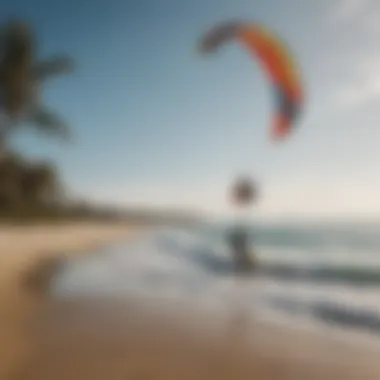
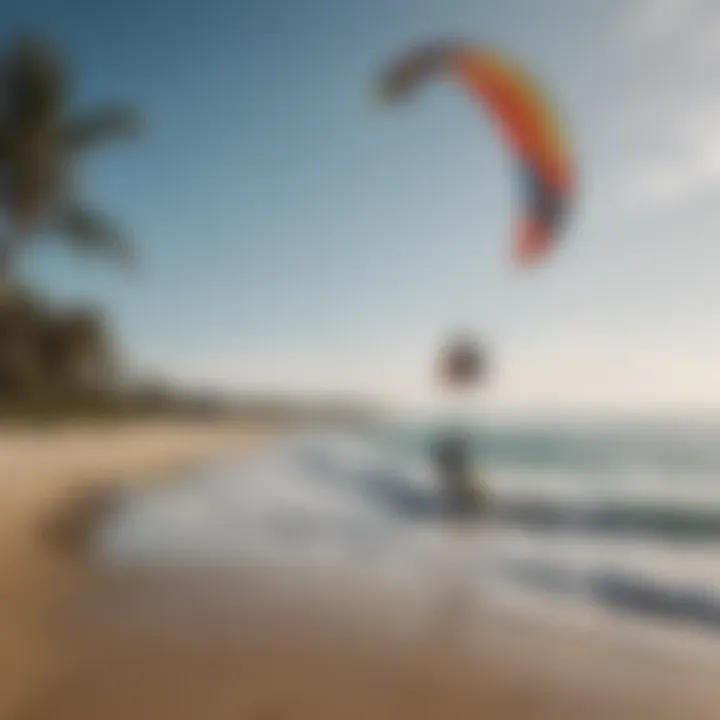
Kitesurfing isn't one-size-fits-all. Each spot may present unique wind and water conditions. Adapting to these challenges is part of what makes one a skilled kiteboarder. Beginners often find solace in perfect weather, but the real test lies in adapting when things go awry.
- Learn to Read the Wind: Understanding how wind direction and speed affect your kite’s performance is crucial. Practice flying your kite on various days with differing conditions so you can familiarize yourself with these elements.
- Experiment with Kite Size: Different kites serve specific weather. Learning to select and maneuver your equipment based on conditions will significantly impact your control. Experiment; sometimes, a smaller kite may give you an edge in stronger winds.
- Practice in Varied Waters: Don't just stick to familiar shores. Try practicing in different environments, whether it’s flat water, choppy surfaces, or waves. Each condition demands different techniques and skills.
The agile mind learns to flow with the tide. By embracing the variability in conditions, kitesurfing becomes not just about the thrills of flying but also about mastering the art of adaptation.
Community and Events
Community engagement in kitesurfing opens up a new realm for both novices and seasoned kiteboarders. Getting involved in local and global kitesurfing communities can enhance the experience significantly. These groups offer tones of support and shared knowledge, creating an inclusive sense of belonging. They are not just places for sharing stoke but are invaluable for learning, networking, and growing your skills. In addition, kitesurfing events, whether local meet-ups or international competitions, present opportunities to connect with like-minded individuals who share the same passion.
Joining Local Kitesurfing Clubs
Joining a local kitesurfing club can be a transformative step in your kitesurfing journey. Clubs are often made up of varying skill levels, which can be very helpful. Beginners can learn from experienced members, while intermediates can push each other towards skill enhancement. Some clubs provide access to equipment, lessons, and even exclusive use of local spots, creating a supportive environment for growth.
Additionally, engaging with a local club can help you gain insider knowledge about conditions, venturing into uncharted waters, and even safety protocols unique to your location. As they say, it’s not just what you know but who you know; forming connections within your local kitesurfing community can open doors to new opportunities, including discounted lessons or travel plans to exciting new destinations with your newfound friends.
Participating in Kitesurfing Competitions
Competing in kitesurfing events can serve multiple purposes. First and foremost, competitions are a fun way to put your skills to the test. Whether you're in it for the glory or just the thrill, pushing yourself in a competitive environment adds an extra layer to your learning experience.
Moreover, regional or national competitions can expose you to varying techniques and styles as participants from different areas often showcase unique tricks or methods of riding. Being part of these gatherings also allows riders to gain visibility. Making yourself known in the community can lead to sponsorship opportunities or invites to larger, more prestigious events. Winning competitions often adds credibility to your skill set and can even foster connections with potential mentors in the sport.
Networking with Other Kitesurfers
Networking in the kitesurfing community can lead to enriching friendships and valuable partnerships. You’ll find that many kitesurfing enthusiasts are eager to share tips, techniques, and even gear recommendations. Utilizing platforms like Reddit or Facebook, community members frequently exchange information and arrange meet-ups or travel plans to share the stoke together.
Such interactions can be the backbone for growth. Whether it’s joining a group chat or participating in forums, having a network of experienced kitesurfers allows you to ask questions, seek guidance, and receive feedback without the pressure of a formal lesson. Often, these informal channels offer insights that you might not gain through traditional learning. Plus, you never know when someone might invite you for a day kiteboarding at a picturesque location you haven’t yet discovered!
"The more connections you make in kitesurfing, the richer your experience will be!"
In summary, participating in kitesurfing communities and events is about sharing experiences, forging bonds and ensuring continual progress in the sport. These aspects enhance not just skills but also friendships that will last a lifetime.
Travel Considerations for Kitesurfing
Traveling for kitesurfing isn’t just about packing your gear; it’s a fully-fledged adventure that can take your skills and enjoyment to new heights. The importance of considering your travel arrangements when embarking on a kitesurfing journey cannot be stressed enough. Not only do you need to research the best spots that align with your skill level, but understanding the logistics, local regulations, and environmental nuances can significantly influence your overall experience. Knowledge about potential hazards, wind patterns, local culture, and community can enhance your kitesurfing exploits and build lasting memories.
Top Kitesurfing Destinations
When it comes to kitesurfing, the world is your oyster. Some spots are so popular among the community for their wind consistency, water conditions, and breathtaking scenery. Here are some top destination pearls:
- Tarifa, Spain: Known as the wind capital of Europe, Tarifa offers milder climate and strong winds year-round. The stunning beaches add to the allure.
- Cumbuco, Brazil: With its extensive lagoons and regular winds, Cumbuco is a haven for riders of all levels, offering warm water and vibrant local culture.
- Nassau, Bahamas: The clear blue waters and light breezes make it a perfect spot for beginners, providing both beauty and challenge.
- Maui, Hawaii: Legendary for its big waves and consistent trade winds, Maui is a must-visit for experienced riders seeking thrills.
With these spots in mind, it's wise to dig deeper into the specifics that each locale can offer.
Preparation for Destination Trips
Preparation is key to ensuring a smooth and enjoyable kitesurfing trip. Here are a few essential steps to consider:
- Research Local Conditions: Check wind patterns, tide charts, and seasonal climates for your destination. Understanding local weather conditions facilitates better planning.
- Pack Carefully: Ensure all your gear is in check—kites, board, harness, and safety gear. Don’t forget essentials like sunscreen and first-aid kits.
- Understanding Regulations: Familiarize yourself with any permits or rules of use in the area to avoid fines and ensure a hassle-free experience.
- Consider Insurance: Travel insurance that covers water sports can come in handy in case of incidents or gear loss.
Cultural Considerations while Traveling
Traveling to kitesurfing destinations presents an opportunity to merge sports with cultural exploration. Respecting local customs can enhance both your experience and your relationships with the community:
- Language Basics: Familiarize yourself with basic phrases in the local language. Even a simple "thank you" can leave a positive impression.
- Beach Etiquette: Each locale may have specific norms regarding beach conduct, so observing and adhering to local practices is crucial.
- Engage with the Community: Joining local kitesurfing clubs or attending local events fosters a sense of community and can provide you with valuable information and tips.
"Kitesurfing is not just a sport; it's a passport to a myriad of cultural experiences while enjoying the thrill of the water."
Culmination
Traveling for kitesurfing not only rewards you with epic sessions on the water but also immerses you in diverse cultures. By addressing the unique needs and considerations related to travel, one becomes more than just a participant in kitesurfing — they transform into a global citizen of the sport, ready to explore and connect.
Future Developments in Kitesurfing
The world of kitesurfing is not static; it evolves at a pace that mirrors advancements in technology and changing environmental considerations. The future developments in this exhilarating sport hold significant relevance for participants – from beginners to seasoned kitesurfers. Embracing these changes can enhance the overall experience and ensure that the sport remains accessible and enjoyable for generations to come.
Innovations in Gear Technology
With every passing year, the gear associated with kitesurfing undergoes refinements that push the boundaries of what's possible on the water. One major trend is the emergence of lightweight materials that improve maneuverability without sacrificing strength. Take for instance the introduction of aramid and carbon fibers in kite construction. These materials help reduce weight while increasing durability, making it easier for riders to stay airborne longer.
- Smart Kites: Another exciting development is the use of technology in kites. Smart kites equipped with sensors can provide valuable feedback to kitesurfers. These sensors monitor wind conditions and kite performance, enabling riders to adjust their techniques in real-time.
- Adjustable Designs: Furthermore, some brands are pioneering adjustable kites that allow users to change aspects of the kite's shape on-the-fly, optimizing performance based on conditions. This flexibility makes the sport more inclusive by accommodating varying skill levels and preferences.
Effective gear is not just about performance; it also plays a crucial role in safety. For instance, new safety releases and quick self-rescue mechanisms are enhancing user confidence. Kitesurfers can now feel secure in exploring challenging conditions, knowing they have reliable equipment at their disposal.
"The evolution of kitesurfing gear has taken the sport to new heights, quite literally, making it safer and more enjoyable for everyone involved."
Environmental Sustainability in Kitesurfing
As the sport grows, so does the responsibility that comes with it. Environmental sustainability in kitesurfing and water sports at large is becoming increasingly important. Kitesurfers have a unique connection to nature, spending countless hours in coastal areas that face various ecological pressures. Addressing these challenges is vital for preserving the beautiful locations we enjoy day in and day out.
- Eco-Friendly Materials: A noteworthy development is the commitment of certain brands to utilize eco-friendly materials in their products. Biodegradable materials not only appeal to eco-conscious consumers but also help reduce landfill waste. Look for companies that are championing these practices; it is a vote for nature.
- Conservation Efforts: Additionally, many kitesurfing clubs are engaging in local conservation efforts. Beach clean-ups and awareness campaigns are more common, emphasizing the role of the kitesurfing community in protecting marine ecosystems. Taking part in these activities can foster a sense of belonging, while also giving back to the environment.
- Eco-Tourism: Another aspect of sustainability is the rise of eco-tourism. Kitesurfing destinations are increasingly adopting practices that not only ensure enjoyment for visitors but also protect local wildlife and flora. Participating in kitesurfing with a sustainable mindset can contribute to a thriving, interconnected ecosystem.
As kitesurfers, we have the power to make informed choices that enhance both our experience and the health of the planet. By staying educated about innovations and sustainable practices, we can make a lasting impact and ensure that kitesurfing thrives for years to come.







